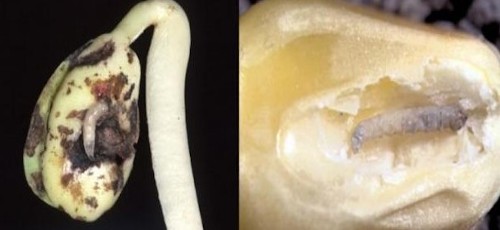By Erin Hodgson
Seedcorn maggot is a seed and seedling pest of corn and soybean. Plant injury is especially prevalent during cool and wet springs. The larvae, or maggots, feed on germinating corn and soybean seeds or seedlings (Photo 1). Feeding can delay development or kill the plant. Infestations tend to be field-wide instead of in patches like for many other pests. To confirm seedcorn maggot injury, check field areas with stand loss and look for maggots, pupae and damaged seeds (hollowed out seeds or poorly developing seedlings).

Biology
Seedcorn maggots overwinter in Iowa as pupae in the soil. Adult flies emerge and mate in April and May, then females lay eggs in soil. Maggot densities are higher in soils with high organic matter. Land that is heavily manured may be especially attractive to early-laying females. Recent soil tillage, regardless of residue type, is attractive to egg-laying females. This fly species has a lower developmental threshold of 39°F and upper threshold of 84°F. Peak adult emergence for the first generation is at 360 accumulated degree days. Based on current accumulated degree days, expect the first generation to be moving around in southern and central Iowa now. There are 4-5 generations of seedcorn maggot per year in our area. Recent freezing temperatures may temporarily slow the development in all areas.